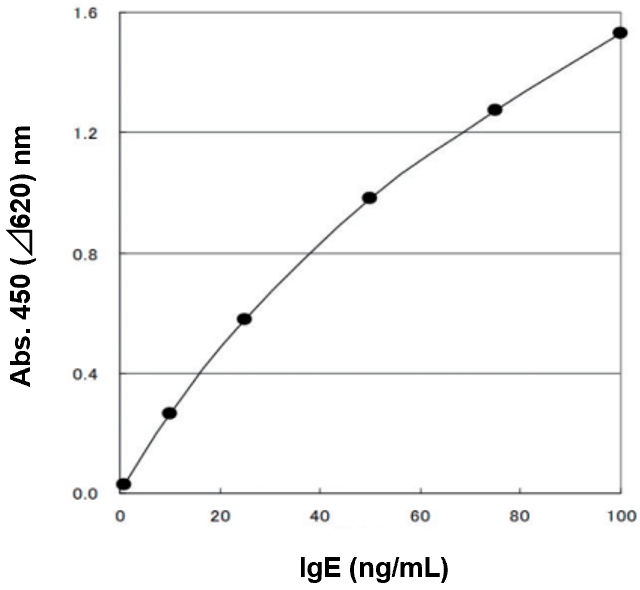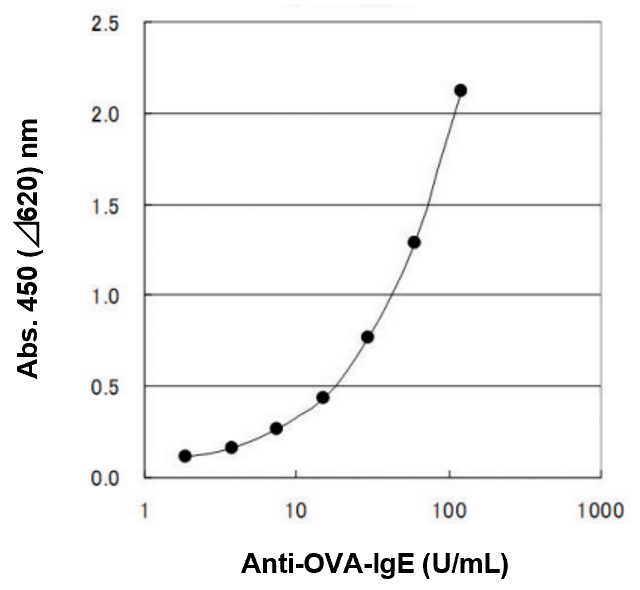IgE ELISA Kits
Immunoglobulin E (IgE) is a glycoprotein of approximately 190 kDa, composed of two Hε chains and two L chains. IgE involved in allergic responses is also referred to as reagin. It is bound, upon sensitization with an allergen, via its Fc region to FcεRI receptors on basophils and mast cells in the skin, respiratory tract, and gastrointestinal tract, thereby sensitizing these cells. Subsequent binding of the allergen to cell-bound IgE triggers degranulation, resulting in the release of histamine, serotonin, proteases, heparin, chemotactic factors, prostaglandins, leukotrienes, and other molecules. These events lead to bronchoconstriction, mucosal edema, and enhanced secretion, and are responsible for type I hypersensitivity reactions, including bronchial asthma, certain forms of urticaria, allergic rhinitis, and anaphylaxis.
What is IgE?
Immunoglobulin E (IgE) is the fifth immunoglobulin to be identified. It is a glycoprotein of approximately 190 kDa, composed of two Hε chains (each with one VH and four CHε [CHε1–4] domains) and two L chains. Electrophoretically, IgE migrates in the γ1 fraction.
IgE has a half-life of about three days and circulates at very low concentrations (around 300 ng/mL) in the serum of healthy individuals. However, its levels increase in response to parasitic infections and in cases of hay fever. IgE involved in allergic responses is also referred to as reagin. It is bound, upon sensitization with an allergen, via its Fc region to FcεRI receptors on basophils and mast cells in the skin, respiratory tract, and gastrointestinal tract, thereby sensitizing these cells. Subsequent binding of the allergen to cell-bound IgE triggers degranulation, resulting in the release of histamine, serotonin, proteases, heparin, chemotactic factors, prostaglandins, leukotrienes, and other molecules. These events lead to bronchoconstriction, mucosal edema, and enhanced secretion, and are responsible for type I hypersensitivity reactions, including bronchial asthma, certain forms of urticaria, allergic rhinitis, and anaphylaxis.
In simplified animal models, immune function can be assessed by immunizing with ovalbumin (OVA) as the antigen and measuring anti-OVA IgE titers.
LBIS™ Mouse IgE ELISA Kit
The LBIS™ Mouse IgE ELISA Kit is a sandwich ELISA kit designed for the quantitative determination of mouse IgE. It utilizes antibodies that are specific to mouse IgE, with minimal cross-reactivity to other immunoglobulin isotypes.
Kit Performance
| Assay target | IgE |
|---|---|
| Calibration curve range | 1-100 ng/mL |
| Analysis sample | Mouse Serum/Plasma |
| Sample volume | 5 μL (10-fold dilution) |
| Measurement duration | Approx. 5 hours 20 minutes |
| Wavelength | Primary wavelength 450 nm Reference wavelength 620 nm |
Example of Calibration Curve

Cross-reactivity with Immunoglobulin
| Animals | Immunoglobulin | Cross-reactivity (%) |
|---|---|---|
| Mouse | IgE (100 ng/mL) | 100 |
| IgG (1 mg/mL) | <0.01 | |
| IgA (1 mg/mL) | <0.01 | |
| IgM (1 mg/mL) | <0.01 | |
| Rat | IgE (100 ng/mL) | <0.1 |
| IgG (1 mg/mL) | <0.01 | |
| IgA (1 mg/mL) | <0.01 | |
| IgM (1 mg/mL) | <0.01 | |
| Human | IgE (100 ng/mL) | <0.1 |
| Bovine | BSA (10 mg/mL) | <0.01 |
Example: Measurement of IgE in Mouse Serum
| Mouse | Number of Samples | Measured value (Average) | SD |
|---|---|---|---|
| NC/Nga, Female, 5-weeks old | 24 | 85 ng/mL | 18 ng/mL |
The measurement values shown above are for reference purposes only. Actual results may vary depending on experimental conditions.
LBIS™ Mouse OVA-IgE ELISA Kit
The LBIS™ Mouse OVA-IgE ELISA Kit is a sandwich ELISA kit designed for the quantitative determination of mouse anti-OVA IgE antibodies. Following immunization with ovalbumin (OVA), the anti-OVA IgE titer can be measured to assess immune function in mice using a simplified experimental model.
Kit Performance
| Assay target | Anti-OVA-IgE |
|---|---|
| Calibration curve range | 1.88-120 U/mL |
| Analysis sample | Mouse Serum/Plasma |
| Sample volume | 5 μL (10 to 50-fold dilution) |
| Measurement duration | Approx. 1 hour 50 minutes |
| Wavelength | Primary wavelength 450 nm Reference wavelength 620 nm |
Example of Calibration Curve

Example: Measurement of OVA-IgE in Mouse Serum
Equal volumes (v/v) of alumina (20 mg/mL) and OVA (50 μg/mL) were mixed. OVA was initially dissolved at 1 mg/mL in 0.1 M carbonate buffer (pH 8.5) and subsequently diluted with saline to a final concentration of 50 μg/mL. Mice were intraperitoneally injected with 0.2 mL of the mixture twice at one-week intervals. Blood was collected three weeks after the injection.
| Mouse | Number of Samples | Measured value (Average) | SD |
|---|---|---|---|
| BALB/c, Male, 8-weeks old | 3 | 139 U/mL | 22.5 U/mL |
The measurement values shown above are for reference purposes only. Actual results may vary depending on experimental conditions.
Product List
- Open All
- Close All
IgE ELISA Kit (Mouse)
Anti-OVA-IgE ELISA Kit (Mouse)
For research use or further manufacturing use only. Not for use in diagnostic procedures.
Product content may differ from the actual image due to minor specification changes etc.
If the revision of product standards and packaging standards has been made, there is a case where the actual product specifications and images are different.



